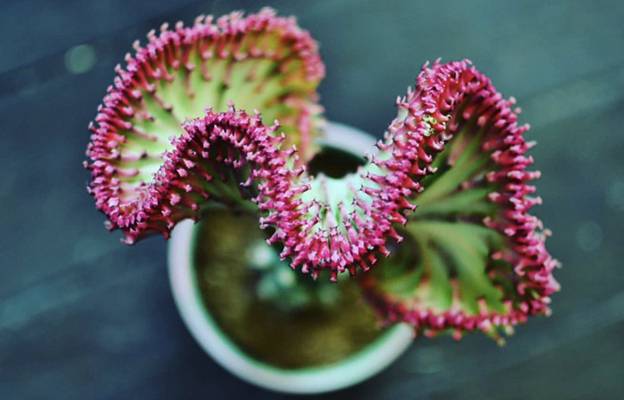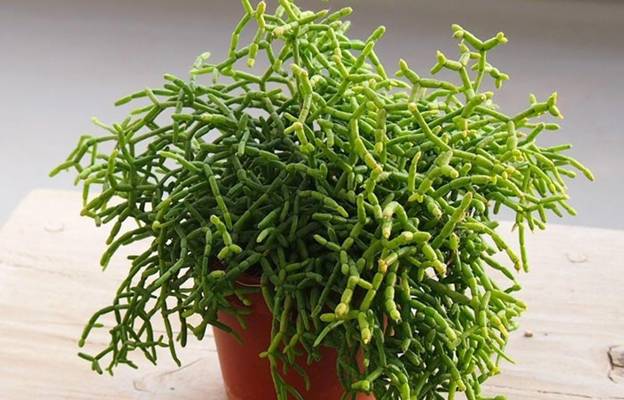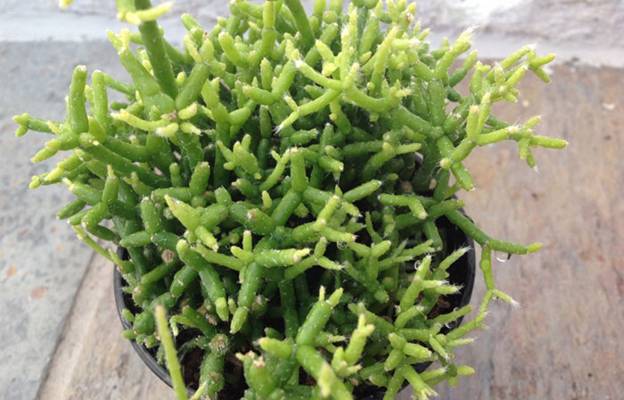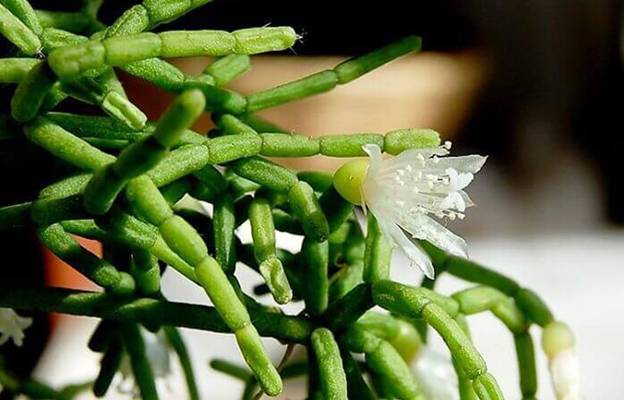Coral Cactus Care Tips (Rhipsalis & Euphorbia)

Coral cactus care actually is not about a cactus; it is about two plants in one. Coral cactus care tips in this article will let you know how to keep this Frankenplant vibrant and healthy. This beautiful houseplant in fact two succulents joined together.
Since there are two famous coral cacti, we are going to review all you need for coral cactus care. Below, we will get to know these striking plants and coral cactus care instructions better.
Before learning about coral cactus care tips, let us solve two of the most common problems that the owners of these plants have:
Coral Cactus Brown Spots
Coral cactus brown spots are a common problem among coral cacti. Coral cactus brown spots are caused by root damage due to excessive watering. If the plant’s pot has no drainage hole, root rot and coral cactus brown spots are inevitable too.
The browned, damaged plant tissue will not recover. But they are not likely to spread if you adjust the watering.
Coral Cactus Dying
Similar to coral cactus brown spots, the problem of coral cactus dying is because of improper watering as well (both over and under-watering). So water on time, and water the soil directly, not the plant.
Euphorbia Coral Cactus Info
Euphorbia lactea cristata is a type of Euphorbia plant from the family Euphorbiaceae. Crown of Thorns (Euphorbia Milii), African Milk Tree, and Euphorbia caput-medusae are among the plants that the coral cactus is related to.
The long-lived and perennial Euphorbia lactea cristata originates from the nurseries of experimental horticulturists. As it is in fact a grafting of two types of Euphorbia: Euphorbia lacteal (crest), and Euphorbia neriifolia (root and stock).
This houseplant has an eye-catching crest-like shape very similar to ocean coral, explaining its most famous common name. Other common names for this coral cactus include Crested Candelabra, Crested Euphorbia, Candelabra, and Crested Elkhorn.
There is a coral cactus flower as well, which is rare. Even when at least one-year-old plant produces pink or purple flowers in the spring, they are very small and hard to notice. The plant’s lifespan varies from 1 to 2 years up to 10 years.

Coral Cactus Care Tips
Euphorbia lactea is a small houseplant that hardly grows more than about two feet in size. The unusual foliage of the plant’s green leaves is truly striking. The upper crest with ruffled edges is green, red, purple, white, or yellow.
To keep this fascinating and avoid other problems such as coral cactus brown spots, keep these coral cactus care instructions:
Water
Check the soil every now and then, and when the top two inches is dry, water your houseplant deeply. Remember that the plant needs more water during its active growing seasons (spring and summer), and less during cold months.
The important thing in coral cactus care regarding water is to avoid excessively dry and excessively wet soil. The first situation causes your houseplant to wither and has an irreversible effect. The latter also causes root, stem rot, and of course coral cactus brown spots.
Light
Euphorbia lacteal enjoys bright, indirect sunlight. If kept indoors, a south-facing bright window is a suitable spot. Make sure to turn your Crested Elkhorn occasionally to prevent having it grow in an unequal manner. If kept outdoors, it grows best in full to partial sun.
If you live in a very hot area, we recommend a location with bright, indirect sunlight like under trees or on a covered patio. If you keep the coral cactus indoors during the cold months and move it outdoors in warm months, do it gradually to avoid burning delicate tissues.
Soil and Feeding
Crested Euphorbia tolerates all soil pH levels. To provide suitable soil in the coral cactus care, you need to go for gritty and well-draining potting soils. You can create it yourself by mixing coarse sand and high-quality soil in equal amounts. If that is not possible, simply use cactus soil or succulent potting soil.
A balanced 10-10-10 liquid fertilizer that is diluted to ¼ strength is recommended for monthly fertilization during spring and summer. So do not fertilize during the fall and winter at all. Also, avoid using granular fertilizer or slow-release fertilizer, as they can damage the plant’s roots.
Temperature
In Euphorbia coral cactus care, the ideal temperature is between 60° to 85° degrees Fahrenheit or 15° to 30° Centigrade. If the temperature outside drops below 50° degrees Fahrenheit or 10° Centigrade, bring your plant indoors, as it is not very winter hardy.
Transplanting
A coral cactus for sale is usually planted in a ceramic container. It may also have a solid mulch of gravel glued together over the top. We think that you should transparent your plant to a new pot as soon as you can for the best coral cactus care. Apart from this situation, you will rarely need to repot it as it is very slow-growing.
Ceramic containers do not provide good air circulation for the roots. Additionally, the solid gravel mulch will prevent you from being able to check the soil moisture before irrigations.
How to repot a cactus? Repot your plant into a terra-cotta pot with drainage holes. During the process, add some organic compost to the planting hole for extra nutrition.

Coral Cactus Pests
Following the coral cactus care tips regarding good airflow, humidity, etc., your plant will not have any problems. Although it is notable that the latex sap of the plant itself protects it against pests. If you cannot provide ideal coral cactus care, it may suffer from common pests like mealybugs, scale insects, spider mites, and fungal infections.
If you notice this problem soon enough, you can remove mealybugs and scale insects by simply wiping them off with a cotton swab and 70% isopropyl alcohol. Do not apply higher concentrations of alcohol as it may burn the green leaves and their flesh.
To eliminate spider mites and their eggs, wash them away with the help of a strong spray of water. And for heavy infestations, a diluted Neem oil spray solution can solve the problem.
Diseases
Common coral cactus diseases are powdery mildew, root rot, and stem rot. For powdery mildew, mix a tablespoon of baking soda with a gallon of water and spray your Crested Euphorbia with it. To help to solve this problem, increase the air circulation around the plant, and reduce humidity as well.
For fungal rots, cut away any mushy, brown parts of the plant and its roots with a clean and sharp knife. Keep in mind that you do not need to apply fungicides to the wounds because the plants’ latex sap itself has fungicidal properties.
Remember that coral cactus brown spots are not a disease, and you can simply prevent it or stop it from spreading by proper watering.
Pruning
If you manage to follow all the coral cactus care instructions, your houseplant will not need grooming. For the maintenance, if you keep the Crested Euphorbia outdoors, give it a shower with the water hose every couple of weeks when you water. This will wash the dust off the surface of the coral cactus green leaves.
If you keep your plant indoors, you only need to prune it when it develops a fungal infection.
Safety
All Euphorbia have a poisonous, latex sap. The sap (even when dried) can cause skin irritation in case of contact. If it gets to your eyes, it can cause severe irritation. And if ingested, it will cause nausea and vomiting. So handle it carefully and use gardening gloves and eye protection, while keeping it away from children and pets.

Rhipsalis Coral Cactus Info
Rhipsalis Cereuscula, commonly called coral cactus, is a small shrubby cactus from the family Cactaceae. It is native to the tropical rainforests of Central and South America. You can commonly find rhipsalis coral cactus in Argentina, Brazil, and Uruguay.
The word “Rhipsalis” in its scientific name is derived from the Ancient Greek word “wickerwork” referring to the shape of the plant. The other word, “Cereuscula”, means small candles or torch, which refers to the shape of the flowering coral cactus.
Rhipsalis Cereuscula is not the only scientific name of this plant. Interestingly, the coral cactus is not the only common name this plant has as well. People may call it Mistletoe Cactus, Epiphytic Cactus, or Rice Cactus.
Coral Cactus Care Instructions
Rhipsalis coral cactus has clusters of bright green stems that usually grow up to 3 feet in length with small rice-shaped joints. At first, these charming stems are cylindrical; becoming dangly as they mature and grow in size. The growing seasons of this shrubby cactus are spring and summer.
Remember that no part of this plant should be ingested by humans or pets as it cactus is toxic. Now, let us review the coral cactus care instructions for it:

Water
Watering is really important in coral cactus care. As a succulent, this plant has typical watering requirements. If growing outdoors, water your cactus every week in spring and summer when the soil feels dry. When the season becomes chilly, cut the watering to half, and do not water in winter.
Providing the perfect soil for this succulent and dry method in coral cactus care boosts the absorption of nutrients.
Light
The minimal lighting needs that this plant has is an advantage in the coral cactus care. Rhipsalis Cereuscula enjoys filtered sun or partial shade. If you can provide an adequate amount of light for your shrubby plant, it will grow well indoors.
But still, Rhipsalis may suffer in direct sunlight. Too much sunlight can burn the coral cactus green leaves.
Soil and Feeding
Providing the right soil is a key part of rhipsalis coral cactus care too. This plant thrives best in potting or gritty soil. If you want your plant to reach its full growth, we recommend mixing organic matter into the soil, although it is optional.
If you want, you can fertilize the rhipsalis coral cactus every two weeks in spring and summer with a balanced liquid 10-10-10 fertilizer. There is no need to feed it in fall and winter.
Temperature
The ideal temperature for the evergreen plant is from 30° to 50° degrees Fahrenheit; which is equivalent to -1° to 10° Centigrade. As you can see, this succulent does not tolerate cold weather well.

Transplanting
For transplanting, choose a pot with good drainage holes. Then, mix one part of sand with potting soil or general-purpose potting soil. Mulch the soil with loose gravel. Lift the plant with tongs or gardening gloves to protect your hands.
Pests and Diseases
Common pests including mealybugs and spider mites are what you should keep an eye for in Rhipsalis coral cactus care. To prevent scale insects, apply rubbing alcohol with cotton; and eliminate spider mites with water spray.
This impressive shrub is also prone to common diseases like powdery mildew, root rot, and fungal rots. Following the coral cactus care instructions, these problems will not bother both you and your beautiful plant.
Pruning
Grooming is not what most people look for in coral cactus care tips. Rhipsalis Cereuscula does not require pruning unless it develops fungal rots. In this case, pruning is necessary to prevent the rot from spreading. Remove the affected parts with a clean and sharp knife or scissors.
Also, make sure to water the rhipsalis coral cactus when the soil feels dry; and avoid overwatering to prevent it from rotting.
Safety
Although this plant is not particularly spiny, it is potentially dangerous. All parts of the plant are poisonous as mentioned, and its white sap can irritate the skin as well. So it is a good idea to place it out of the reach of small children and pets.
The hairy cactus is another type of cactus.
Coral Cactus Propagation
Rhipsalis coral cactus Propagation is quite simple. All you need to do is take a cutting from the stem using a sharp, sterilized knife. Let it dry for a day or two, and then plant it in a well-draining potting mix. Water the stem cutting when the soil is completely dried out.
- In this post:
- Coral Cactus Brown Spots
- Coral Cactus Dying
- Euphorbia Coral Cactus Info
- Rhipsalis Coral Cactus Info
- Coral Cactus Propagation



